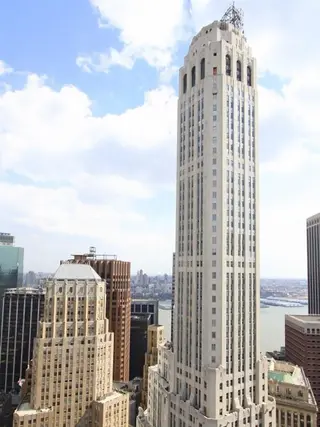 Carter Horsley
Carter HorsleyDec 23, 2011
Carter's Review
Designed by Cross & Cross in 1931 for the City Bank-Farmers Trust, this limestone-clad skyscraper quickly became an important component of what would be the world's most romantic and famous skyline for several decades.
When it was erected, it was the fourth tallest building in the world and it is notable for its very slender tower, its 14, ominous but very impressive hooded busts at the top of its 19th floor setback and its spectacular, domed lobby with gold-toned travertine floor and decorative nickel and bronze.
The 685-foot-high building has a 24-hour doorman and concierge and valet, a fitness center, a landscaped sundeck on the 19th floor, a residents' lounge, and a bicycle room.
In his July 20, 2008 "Streetscapes" column in The New York Times, Christopher Gray provided the following commentary about this great Art Deco tower:
"Fifty-nine stories does not seem like much now, but when planned in 1929, the City Bank-Farmers Trust Building was to be the tallest skyscraper in the world after the Empire State Building. With its sheer limestone façade, haunting sculptural treatment and rich marble halls, the building - which is being converted to residential use - is a surprising find on its cramped, odd-shaped block at Exchange Place at the conjunction of Beaver, Hanover and William Streets.
"In 1929, the financial center was booming. The architects Cross & Cross were at work on a 50-story building for Continental Bank at Broad Street and Exchange Place, which ultimately wasn't built. Then the National City Bank merged with the Farmers' Loan and Trust Company, and entered the skyscraper sweepstakes. When their architects, also Cross & Cross, filed plans at the Bureau of Buildings on Oct. 2, The New York Times described the new structure, at 71 stories and 846 feet, as the highest ever officially proposed. The design for the City Bank-Farmers Trust tower called for an illuminated globe on top, but the stock market crash a few weeks after filing brought the project up short, and it was reduced to 59 stories....
"The magazine Through the Ages said in 1931 that [the hooded figures on the façade]...represented 'giants of finance, seven smiling, seven scowling.' Figures of coins on the ground floor represented countries in which the bank had its main branches....According to a 1931 article in Architecture and Building, the two lavish lobbies were fashioned from 45 different kinds of marble, quarried in Germany, Italy, Czechoslovakia, France, Spain, Belgium and elsewhere. The brothers Eliot and John Walter Cross formed a talented and versatile partnership....Their most recognizable design is probably the sumptuously plain Tiffany & Company store at 57th Street and Fifth Avenue, which dates to 1940."
The tower was acquired for $152 million in 2004 by Nathan Berman, Yaron Bruckner and Eastbridge NV.
Cross & Cross also designed the great midtown skyscraper at 570 Lexington Avenue that was originally planned to be occupied by RCA Victor.
In their great book, "New York 1930,, Architecture and Urbanism Between The Two World Wars," Robert A. M. Stern, Gregory Gilmartin and Thomas Mellins noted that "Cross & Cross replaced the Expressionist allusion of their RCA Victor tower with those of Modern Classicism, the style for which the designers were better known and which had virtually become the vernacular language of banking."
"The building," the authors continued, "was erected in a remarkably brief span of time, opening for business in 1931, one day less than a year after the first steel column was put in place....Housing two independent banks that each required ground floor accommodations, the ground-floor plan was more intricate than that of any other skyscraper of the era....the banks were each placed at prominent corners; stairs led down half a level from Hanover Street to the fan-shaped banking room of the Canadian Bank of Commerce, while an entrance at the corner of Exchange Place and William Street led diagonally into the lobby of the National City Bank branch, a glorious rotunda sheathed in stone and ringed with red marble columns topped by American eagles. The ceiling was a spectacular reinterpretation of a Classical dome. Stepped concentric rings stenciled in black and silver mounted up to a plastic hemisphere, a Machine Age oculus that washed the room with light reflected from concealed fixtures....Among the building's modern features that seemed especially to impress the press of the day...were an elaborate pneumatic tube system, a building-wide circulating ice water system, a basement reservoir of liquid soap, a new bronze substitute of nickel alloy with copper, three-way duct lines, the largest telephone exchange ever constructed, and a new-fangled double-decker elevator that serviced two floors at once."
The joint venture involving Mr. Berman also converted the former headquarters of Brown Brothers Harriman to 476 rental apartments at 63 Wall Street and the building at 67 Wall Street to about 350 rental units.
Avinash K. Malhotra was the architect for the conversion of this tower.

- Rental built in 1931
- Converted in 2008
- Located in Financial District
- 736 total apartments 736 total apartments
- Doorman
- Pets Allowed
 6sqft delivers the latest on real estate, architecture, and design, straight from New York City.
6sqft delivers the latest on real estate, architecture, and design, straight from New York City.
